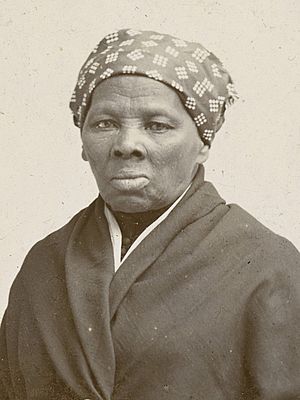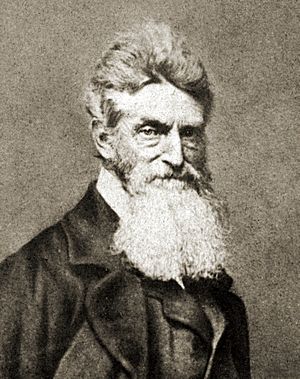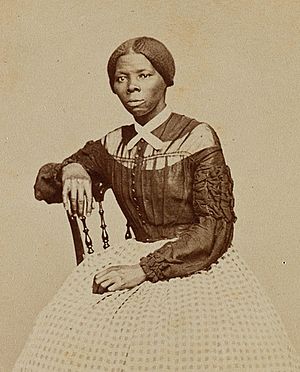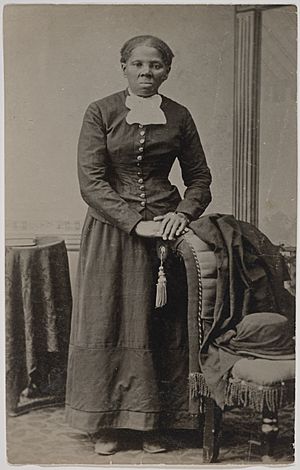Harriet Tubman facts for kids
Quick facts for kids
Harriet Tubman
|
|
|---|---|

Tubman in 1895
|
|
| Born |
Araminta Ross
c. March 1822 |
| Died | March 10, 1913 (aged 90–91) Auburn, New York, U.S.
|
| Resting place | Fort Hill Cemetery, Auburn, New York, U.S. |
| Other names |
|
| Occupation |
|
| Known for | Guiding enslaved people to freedom |
| Spouse(s) |
John Tubman
(m. 1844; div. 1851)Nelson Davis
(m. 1869; |
| Relatives | Family |
Harriet Tubman (born Araminta Ross, around March 1822 – March 10, 1913) was an African-American who fought against slavery. She was also a kind person who helped others. During the American Civil War, she was a Union spy. She was the first Black woman to lead a mission in that war.
Harriet Tubman was born into slavery but managed to escape to freedom. After gaining her own freedom, she made 13 trips back to rescue about 70 enslaved people. These included her family and friends. She used a secret network called the Underground Railroad.
When Tubman was a child in Dorchester County, Maryland, she was often whipped and beaten by her enslavers. When she was very young, an angry overseer threw a heavy metal weight at another enslaved person. The weight accidentally hit Tubman's head. This caused her to have seizures, headaches, and vivid dreams for the rest of her life. Tubman believed these visions and dreams came from God.
In 1849, Tubman escaped to Philadelphia, where slavery was against the law. She later returned to Maryland to rescue her family. She eventually helped many other enslaved people find freedom. Slave owners offered large rewards for their return. But Tubman was never caught because no one knew she was the one helping people escape.
When the American Civil War started, Tubman worked for the Union Army. She first worked as a cook and nurse. Later, she became an armed scout and spy. She was the first woman to lead an armed group in the war. She guided the Combahee River Raid, which freed more than 700 enslaved people in South Carolina. After the war, she moved to her home in Auburn, New York. There, she took care of her elderly parents. She also became active in the women's suffrage movement, which fought for women's right to vote. She continued this work until she became ill. Near the end of her life, she lived in a home for elderly African Americans. She had helped create this home years earlier.
Contents
- Harriet Tubman's Early Life
- How Did Harriet Get Her Head Injury?
- Harriet's Family and Marriage
- Escaping Slavery
- Harriet Tubman and John Brown
- Life in Auburn, New York
- Harriet Tubman During the Civil War
- Harriet Tubman's Later Life
- Famous Quotes by Harriet Tubman
- Interesting Facts About Harriet Tubman
- Images for kids
- See also
Harriet Tubman's Early Life
Tubman's mother, Rit, was a cook. Her father, Ben, was a woodsman who worked with timber on a plantation. Ben and Rit got married around 1808. They had nine children together. Harriet, whose birth name was Minty, was born around 1822.
What Was Harriet's Childhood Like?
Tubman's mother was owned by Mary Pattison Brodess and later by her son, Edward. Rit worked as a cook in "the big house." This meant she had very little time with her own family. Harriet often took care of her younger brothers and sisters. This was common in large families.
When she was about five or six years old, Brodess hired her out to a woman named "Miss Susan." Tubman was told to watch the baby. If the baby woke up and cried, Tubman was whipped. She later said she was whipped five times before breakfast one day. She had scars from these beatings for the rest of her life. Harriet found ways to resist. She ran away for five days once. She also wore many layers of clothing to protect herself from beatings. Sometimes, she even fought back.
As a child, Tubman also worked for a planter named James Cook. She had to check muskrat traps in nearby marshes. She did this work even after she got measles. She became so sick that Cook sent her back to Brodess. After Harriet's mother helped her get better, Brodess hired her out again. Tubman later spoke about how much she missed her home as a child. When she was older and stronger, she worked in the fields and forests. She drove oxen, plowed, and moved logs.
How Did Harriet Get Her Head Injury?
One day when she was a teenager, Tubman was sent to a store for supplies. There, she saw an enslaved person who had left the fields without permission. His overseer was angry and told Tubman to help hold the young man. Tubman refused. As the enslaved person ran away, the overseer threw a two-pound weight at him. The weight hit Tubman instead.
Tubman said the weight "broke my skull." She believed her hair, which was thick and stood out, might have saved her life. Bleeding and unconscious, Tubman was taken back to her owner's house. She lay on a loom seat and received no medical care for two days. She was then sent back to the fields, "with blood and sweat rolling down my face until I couldn't see."
She began having seizures and would suddenly fall unconscious. She later said she was aware of what was happening around her even when she seemed asleep. These episodes scared her family because they couldn't wake her. This condition stayed with Tubman for the rest of her life. Doctors today think she might have had temporal lobe epilepsy because of the injury.
Harriet's Family and Marriage
Around 1844, Tubman married a free Black man named John Tubman. We don't know much about him or their time together. Their marriage was difficult because Harriet was enslaved. Any children born to Harriet and John would also be enslaved, as children took the status of their mother.
At this time, about half of the Black people on the Eastern Shore of Maryland were free. Marriages between free and enslaved people were common. Most African-American families had both free and enslaved members. It's possible that Harriet and John might have planned to buy Harriet's freedom.
Escaping Slavery
In 1849, Harriet became ill again. This made her less valuable to Edward Brodess, who tried to sell her. Edward could not sell her and died soon after. Edward's wife, Eliza, then started to sell the family's enslaved people.
Tubman did not wait to be sold. She escaped with two of her brothers, Ben and Henry. However, her brothers soon changed their minds about escaping and made Harriet return with them.
Soon after, Tubman escaped again, this time without her brothers. She later explained her decision: "I had reasoned this out in my mind; there was one of two things I had a right to, liberty or death; if I could not have one, I would have the other."
Harriet Tubman and John Brown

In April 1858, Tubman met abolitionist John Brown. Harriet did not agree with John Brown's idea of using violence against white people. However, she did help him by sharing what she knew about secret networks and resources in the border states. Brown asked Tubman, whom he called "General Tubman," to find formerly enslaved people who might want to join his fighting group.
On May 8, 1858, Brown held a meeting where he shared his plan for a raid on Harpers Ferry, Virginia (now West Virginia). Tubman helped with the plans. But when it was time for the attack, Tubman could not be found.
The raid failed. Brown was found guilty of treason, murder, and starting a slave rebellion. He was hanged in December.
Life in Auburn, New York
In early 1859, a Republican U.S. Senator named William H. Seward sold Tubman a small piece of land. It was on the edge of Auburn, New York, and cost $1,200. This land in Auburn became a safe place for Tubman's family and friends. For many years, she took in relatives and people who needed a place to stay. She offered a safe home for Black Americans looking for a better life in the North.
Harriet Tubman During the Civil War
When the Civil War began in 1861, Tubman believed that a Union victory was important for ending slavery. Harriet wanted to use her skills to help the Union. Soon, she joined a group of abolitionists who helped people who had escaped slavery.
Tubman worked as a nurse in Port Royal. She made medicines from local plants and helped soldiers who were sick with dysentery. She also helped men with smallpox and, amazingly, she did not get the disease herself.
Scouting and the Combahee River Raid
When President Lincoln finally issued the Emancipation Proclamation in January 1863, Tubman saw it as a big step toward freeing all Black people from slavery. She began leading a group of scouts in an area that was similar to where she grew up. She used her knowledge of how to travel secretly. She gave Colonel James Montgomery important information that helped him capture Jacksonville, Florida.
Later that year, Tubman helped Montgomery again. She became the first woman to lead an armed attack during the Civil War. Tubman guided three steamboats around Confederate mines in the water. As Montgomery and his troops set fire to several plantations, the steamboats blew their whistles. Enslaved people from all over the area ran to the boats. Confederate troops were too late to stop the steamboats, which were full of enslaved people. The boats then headed toward Beaufort, South Carolina.
More than 750 enslaved people were rescued in the Combahee River Raid. For two more years, Tubman worked for the Union. She helped the newly freed people, scouted into Confederate areas, and nursed wounded soldiers in Virginia. She also made some trips back to Auburn to visit her family and care for her parents. After the Confederacy gave up in April 1865, Tubman worked for several more months before heading home to Auburn.
Harriet Tubman's Later Life
Even though Harriet Tubman served the U.S. government for years, she did not receive a regular salary. Tubman spent her last years in Auburn, taking care of her family and other people who needed help. She worked different jobs to support her elderly parents. She also took in people who paid to stay at her home to help with bills. Her friends and supporters from her earlier anti-slavery days helped raise money to support her.
Fighting for Women's Rights
In her later years, Tubman worked to help the cause of women's suffrage. This was the movement for women to get the right to vote. She worked with other women like Susan B. Anthony and Emily Howland. Harriet traveled to cities to speak out for women's voting rights. She talked about her actions during and after the Civil War. She used the sacrifices of many women throughout history as proof that women were equal to men.
Her Church, Illness, and Death
Around 1900, Tubman became involved with the African Methodist Episcopal Zion Church in Auburn. In 1903, she gave a piece of land she owned to the church. She wanted it to be made into a home for "aged and indigent (poor) colored people." The home opened five years later. Tubman was upset that the church made residents pay a $100 entrance fee. She wished that people would not have to pay anything to live there.
In the late 1890s, Harriet had brain surgery to help with the seizures and headaches that continued to bother her. The surgery helped her for a while. By 1911, Tubman began living in the rest home she helped start, the Harriet Tubman Home for the Aged. She died of pneumonia in 1913. She was buried with special honors at Fort Hill Cemetery in Auburn.
Many museums and historical sites have been named after Tubman. She is also the subject of many works of art, including songs, novels, sculptures, paintings, movies, and plays.
Famous Quotes by Harriet Tubman
- “I said to the Lord, 'I’m going to hold steady on to you, and I know you will see me through.'”
- “I would make a home for them in the North, and the Lord helping me, I would bring them all here.”
- “If a person would send another into bondage, he would, it appears to me, be bad enough to send him into hell if he could.”
- “I ain’t got no heart to go and see the sufferings of my people played on the stage."
- “I was the conductor of the Underground Railroad for eight years, and I can say what most conductors can’t say; I never ran my train off the track and I never lost a passenger.”
- “I looked at my hands to see if I was the same person now that I was free.”
Interesting Facts About Harriet Tubman
- When Harriet was helping enslaved people to freedom, her code name was "Moses." She was also known as the "black ghost."
- She used spiritual songs as secret messages for the people following her.
- When she had brain surgery for her seizures and headaches, she did not receive anesthesia (medicine to make her numb or sleep). Instead, she bit down on a bullet, just as she had seen Civil War soldiers do.
- Harriet Tubman has two National Park sites dedicated to her: the Harriet Tubman Underground Railroad National Historical Park in Dorchester County, Maryland, and the Harriet Tubman National Historical Park in Auburn, New York.
Images for kids
-
Frederick Douglass, who worked for slavery's abolition alongside Tubman, praised her in print.
-
Harriet Tubman Museum in Cape May, New Jersey
-
Statue by Jane DeDecker commemorating Tubman in Ypsilanti, Michigan
See also
 In Spanish: Harriet Tubman para niños
In Spanish: Harriet Tubman para niños













